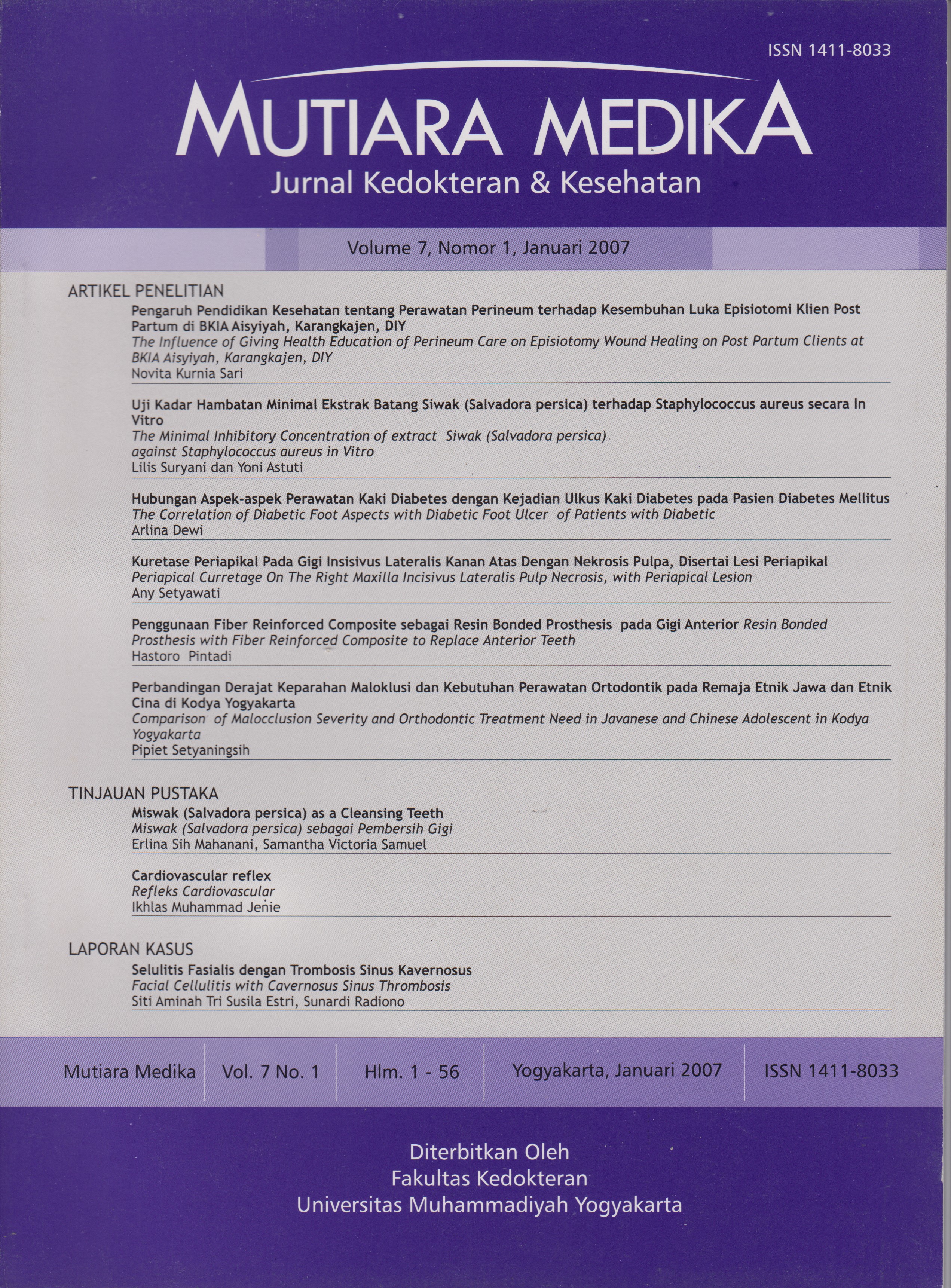Perbandingan Derajat Keparahan Maloklusi dan Kebutuhan Perawatan Ortodontik pada Remaja Etnik Jawa dan Etnik Cina di Kodya Yogyakarta
DOI:
https://doi.org/10.18196/mmjkk.v7i1.1695Keywords:
Maloklusi, Perawatan ortodontik, Etnik Jawa, Etnik Cina, Chinese ethnic, Javanese ethnic, Malocclusion, Orthodontic treatmentAbstract
Malocclusion is a deviate dental occlusion the numbers and type of the deviation, are varied. The purpose of this study was to obtain the differences of malocclusion severity and orthodontic treatment need between Javanese and Chinese adolescent in Kodya Yogyakarta. The study was carried on 200 subjects consisted of 100 subjects Javanese and 100 subjects Chinese adolescent in Kodya Yogyakarta.The Dental Aesthetic Index was used to measured degree of malocclusion, while the questionnaires in The Dental Aesthetic Index was used to measure the orthodontic treatment need. The t - test was used to find out the differences of malocclusion degree and orthodontic treatment need between Javanese and Chinese adolescent ethnic with significance 0,05. The result showed there were no significant differences neither malocclusion degree nor the orthodontic treatment need between Javanese and Chinese adolescent etnhic in Kodya Yogyakarta (p > 0,05). Conclusion: There were no difference about the differences of physic, culture and dietic habit to neither malocclusion degree nor orthodontic treatment need between Javanese and Chinese adolescent ethnic in Kodya Yogyakarta.
Maloklusi adalah oklusi gigi geligi yang menyimpang dari normal, penyimpangan tersebut berupa ciri maloklusi yang jumlah dan macamnya bervariasi baik pada tiap individu maupun pada kelompok populasi. Tujuan penelitian adalah untuk mendapatkan perbedaan keparahan maloklusi dan kebutuhan perawatan ortodontik antara remaja etnik Jawa dan etnik Cina di Kodya Yogyakarta, sehubungan dengan perbedaan fisik, budaya dan kebiasaan makan. Penelitian dilakukan pada 200 subjek yang terdiri dari 100 subjek remaja etnik Jawa dan 100 subjek remaja etnik Cina di Kodya Yogyakarta. Pengukuran keparahan maloklusi dilakukan dengan menggunakan Dental Aesthetic Index. Kebutuhan perawatan ortodontik diukur dengan menggunakan kuesioner yang terdapat dalam Dental Aesthetic Index. Uji t, digunakan untuk mengetahui perbedaan keparahan maloklusi dan kebutuhan perawatan ortodontik antara remaja etnik Jawa dan etnik Cina dengan tingkat kemaknaan 0,05. Hasil penelitian menunjukkan tingkat keparahan maloklusi dan kebutuhan perawatan ortodontik antara remaja etnik Jawa dan etnik Cina di Kodya Yogyakarta.
References
World Health Organization, 1971, Oral health surveys, Basic Methods, Genewa
Djokosalamoen, S., 1983, Studi pola morfologi dental untuk menentukan keparahan maloklusi dan kebutuhan akan perawatan ortodontik, Disertasi, Airlangga University Press., Surabaya.
Prahl-Anderson, B., 1978, The Need for Orthodontic Treatment, The Angel Orthod, 48: 1-8.
Cons, N.C., Jenny J., Kohout F.J., 1986,
DAI: The Dental Aesthetic Index, University of Iowa, Iowa City.
1988, Guidelines for Using The DAI A Supplement to DAI: The Dental Aesthetic Index, University of Iowa of Iowa City.
Jenny, J. dan Cons, N.C., 1995, DAI: The Dental Aesthetic Index, Summary October p: 1-11.
Partosuwido, S.R., Wirawan, Y.G., As’ad, Moh., Murtini., Singgih, W.S., 1979, Perbandingan Konsep Diri Anak-Anak Remaja Warga Negara Indonesia Asli dan Keturunan Tionghoa, (Laporan Penelitian), Fakultas Psikologi UGM.
Krisnawati, 1996, Kecenderungan Perawatan Ortodonti dengan pencabutan Gigi ditinjau dari Faktor Usia, Jenis Kelamin, dan Maloklusi, Ceril VI , Edisi Khusus, FKG, h.263-280
Harkati-Dewanto, 1987, Ciri-ciri Maloklusi Suku Jawa Pedesaan dan Kota di Yogyakarta, Naskah Lengkap Foril II, FKG Universitas Tri Sakti, Jakarta.
1993, Aspek-Aspek Epidemologi Maloklusi, Gadjah Mada University Press, Yogyakarta
Martorell, R., Yarbrough, C., Lechtig, A., Delgado, H., dan Klein, R.E., 1977, Genetic environmental interaction in physical growth, Acta Paediart. Scand. 66: 578-587.
Potter, R.H., Nance, W.E., dan Davis, W.B., 1976, A twin study of Dental Dimension II. Independent genetic determinants. Am. J. Phys. Anthrop. 44: 397-412.
Smith, R.J., dan Bailit, H.L., 1977, Problems and Methods in Research on the Genetics of Dental Occlusion. Angel Orthod. 47(1): 65-77.
Heldt, L., Haffke, E.A., dan Davis, L.F., 1982, The Psychological and social aspects of orthognathic treatment, Am. J. Orthod. 82(4): 318-327.
Arnett, G.W., dan Worley, C.M., 1999, The treatment motivation survey: Defining patient motivation for treatment, Am. J. Orthod. Dentofacial Orthop. ; 115: 233-238.
Knutson, J.W., 1980, Kecenderungan Perawatan Orthodontics dengan Pencabutan Gigi ditinjau dari Faktor Usia, Jenis Kelamin, dan Maloklusi, Ceril VI, Edisi Khusus, FKG UGM, h.263-280.
Downloads
Published
Issue
Section
License
Copyright
Authors retain copyright and grant Mutiara Medika: Jurnal Kedokteran dan Kesehatan (MMJKK) the right of first publication with the work simultaneously licensed under an Attribution 4.0 International (CC BY 4.0) that allows others to remix, adapt and build upon the work with an acknowledgment of the work's authorship and of the initial publication in Mutiara Medika: Jurnal Kedokteran dan Kesehatan (MMJKK).
Authors are permitted to copy and redistribute the journal's published version of the work (e.g., post it to an institutional repository or publish it in a book), with an acknowledgment of its initial publication in Mutiara Medika: Jurnal Kedokteran dan Kesehatan (MMJKK).
License
Articles published in the Mutiara Medika: Jurnal Kedokteran dan Kesehatan (MMJKK) are licensed under an Attribution 4.0 International (CC BY 4.0) license. You are free to:
- Share — copy and redistribute the material in any medium or format.
- Adapt — remix, transform, and build upon the material for any purpose, even commercially.
This license is acceptable for Free Cultural Works. The licensor cannot revoke these freedoms as long as you follow the license terms. Under the following terms:
Attribution — You must give appropriate credit, provide a link to the license, and indicate if changes were made. You may do so in any reasonable manner, but not in any way that suggests the licensor endorses you or your use.
- No additional restrictions — You may not apply legal terms or technological measures that legally restrict others from doing anything the license permits.






